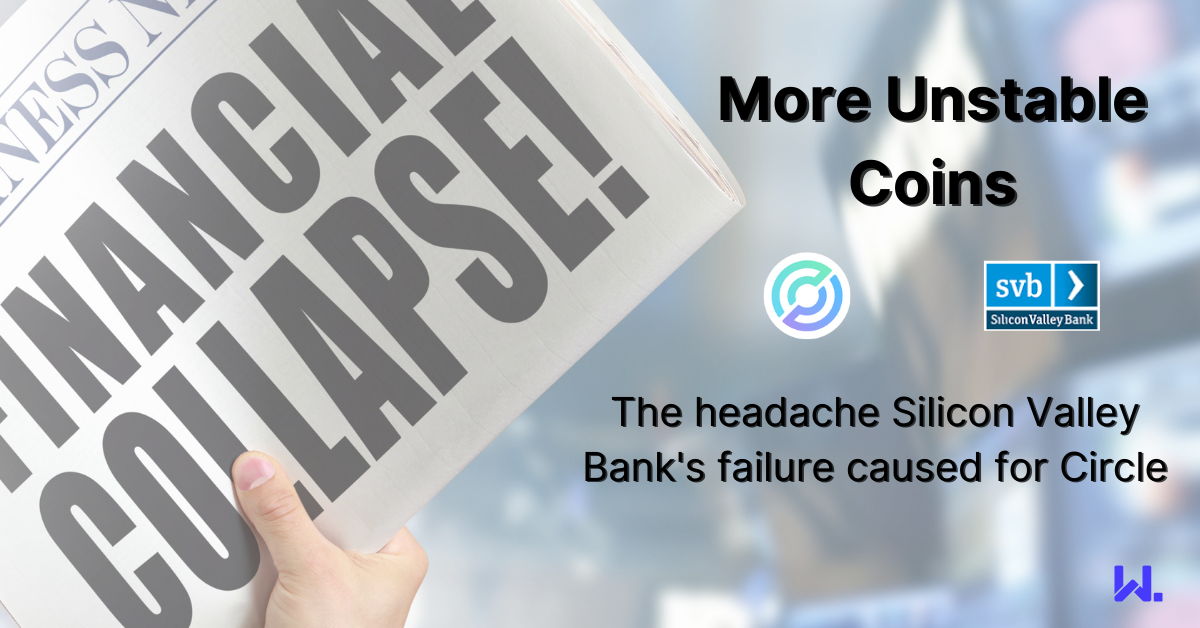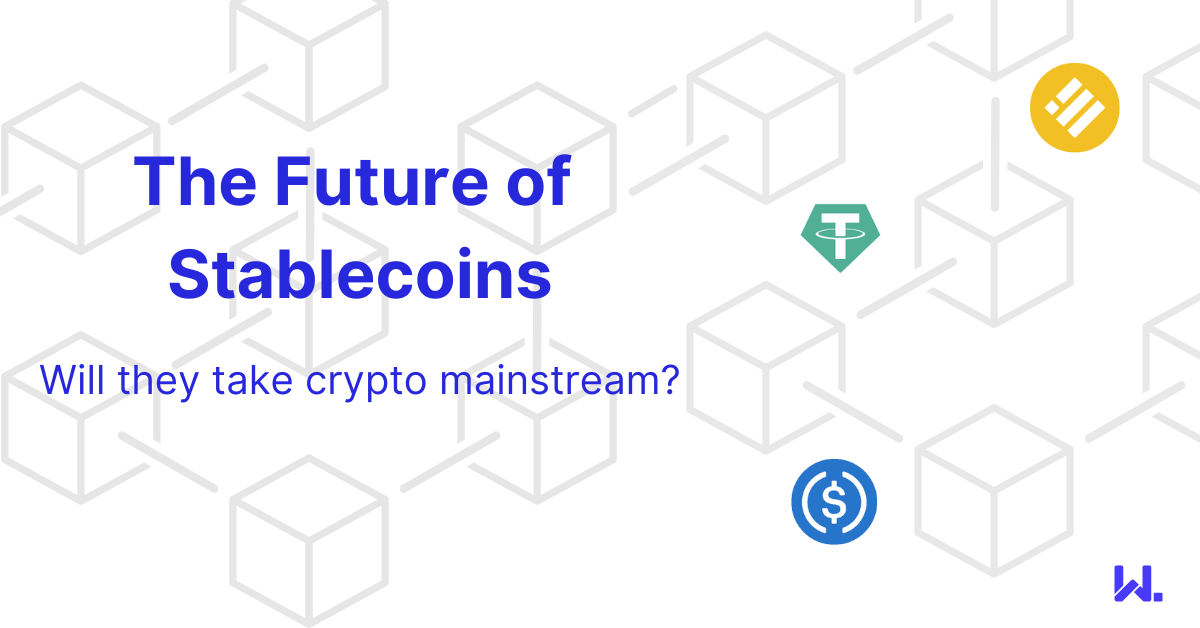More Unstable Coins: Effects of Silicon Valley Bank's Failure
After a year of numerous crypto failures, this week marked a change in that we saw the failure of a TradFi institution — Silicon Valley Bank (SVB). SVB saw a bank run happen following its announcement that it needed to raise USD $1.75bn to plug a hole in its bond portfolio.
Silicon Valley Bank was the 16th largest bank in the US before the collpase. Why is this relevant? They focused on providing financing & banking services to venture-backed tech startups. They were the preferred bank for many in the tech sector because of this.
The headache Silicon Valley Bank's failure caused for Circle
SVB was hit hard by the crunch in bond prices we saw this past year. Following a record period of low-interest rates, last year they started to rise again, resulting in bond prices taking a hit. SVB had invested significant deposit reserves in long-dated bonds and saw the value of these holdings decrease significantly.
What was most surprising to me was the knock-on effect it had within the crypto ecosystem. The stablecoin USDC had some of its collateral stored with SVB. At one point it was trading below 90 cents on the dollar. The actual amount with SVB was $3.3bn of their $40bn in reserves.
1/ Following the confirmation at the end of today that the wires initiated on Thursday to remove balances were not yet processed, $3.3 billion of the ~$40 billion of USDC reserves remain at SVB.
— Circle (@circle) March 11, 2023
Bizarrely, throughout this entire episode, USDC's rival and popular stablecoin, Tether's USDT remained pegged to the dollar and at one point was trading at a premium of $1.06 on Kraken.
$USDT "depegged" to the upside, worth 1.06 $USD and 1.08 $USDC today. $USDC dipped to 0.89 $USD. You have to wonder if the market is losing faith in US-homed financial products.
— Jesse Powell (@jespow) March 11, 2023
Board: https://t.co/ndnGPaSwmm pic.twitter.com/Fi6Fh5mSQk
USDT has come under much scrutiny over the years due to a lack of transparency on what the reserves underpinning this stablecoin are made up of. In this instance, this lack of transparency provided a boon for USDT which in certain respects shows just how dysfunctional the crypto markets still are at times.
Circle has always tried to lead by example within the crypto market by providing fully audited accounts and transparency of how USDC is collateralised. And while the SVB failure was not good, the failure of the bank was due to poor risk management, and those investments had not gone to zero.
Whilst for a few days there was uncertainty around the fate of the bank, the market effectively marking the collateral that Circle stored with them down to zero appeared unfounded. For many, a 10% discount on USDC would have presented an excellent buying opportunity for a quick profit, provided they were willing to hold on to their USDC.
It did also highlight some of the challenges that much of the crypto and web3 ecosystems are exposed to. Unless users are willing to fully embrace native web3 currencies such as bitcoin and Ether, failures within the TradFi ecosystem are likely to have significant knock-on effects to crypto too.
As native crypto assets are incredibly volatile, many users park their crypto holdings in stablecoins. These stablecoins use TradFi infrastructures to store their collateral, as they are underpinned by TradFi assets, be that fiat currencies or securities.
This means that currently many crypto holders get the worst of both worlds. They are exposed not just to risks of theft, rug-pulls, etc, but also if any of the companies or products they are using make use of TradFi infrastructures, there is a potential systematic risk from those institutions too.
One potential approach that may help would be if some type of government-backed stablecoins existed — e.g. a fully sanctioned central bank digital currency (CBDC). These are controversial in some circles, but they shouldn't be, provided end-user privacy is protected.
Currently, we have intermediary upon intermediary stacking their services upon one another. Circle provided an on-chain dollar representation, which is a centralised actor. They in turn have collateral invested in short-dated U.S. treasuries, and funds spread across a number of banks.
This is all to create a token that tracks the value of a dollar on a number of different blockchains.
Now it is fantastic that such an asset exists in the ecosystem and gives crypto and DeFi users an on-chain asset with greater price stability than their native assets. However, all of these different services they have integrated with in order to provide an on-chain dollar are not without risk, as events have highlighted.
In this context, is it not such a bad thing to try to enact regulation that will bring us closer to having CBDCs in some form, which are guaranteed by central banks?
It is clear after the collapse of SVB that for stablecoins to work at scale and to be true settlement assets, they will need to be backed by cash on deposit at the central bank. And the wholesale leg is the starting point. @fnality, what do you think?
— John W. |🇮🇪🇺🇸🇪🇸🇪🇺| (@_JohnWhelan) March 11, 2023
I doubt this will be the last time that the brittleness of our existing financial institutions and system spills over into crypto. The widespread adoption of stablecoins is a testament to their demand. Given this, one hopes that central bankers are taking note. Rather than an ever-increasing number of workarounds being implemented to synthesise assets on-chain as is currently the case, we should find ways to eliminate these layers of complexity and bring more native assets on-chain.
One day I hope we will be able to use services such as Uniswap to take a central bank-guaranteed digital dollar or pound and swap it for a native protocol token such as Ether. This is the future that the crypto and DeFi projects should be aiming for.
One where we have minimal services layered on top of one another, where if a failure were to happen it would be as close to the native layer as possible — i.e. at the central bank, in the DEX code or in the blockchain protocol, not in one of the many intermediaries that have been used to synthesise the service.
Perhaps such a place is considered unattainable, but we can do better than where we are now.
Banks and other TradFi institutions will fail again in the future. No doubt we haven't seen the last failure of a crypto or DeFi project either. We need to find ways to simplify the bridging of the native assets in TradFi to web3, or simply go our own way in web3.
Removing some of the sticky tape in our existing systems and creating true on-chain assets be that currencies or securities will help us to get there. So perhaps now’s the time to think in terms of CBDCs being the right building block for bringing fiat currencies on-chain, and discouraging the workarounds that we've become accustomed to these past 5 years. As events of the past week have shown, web3 is not immune to failures in the broader financial system.




